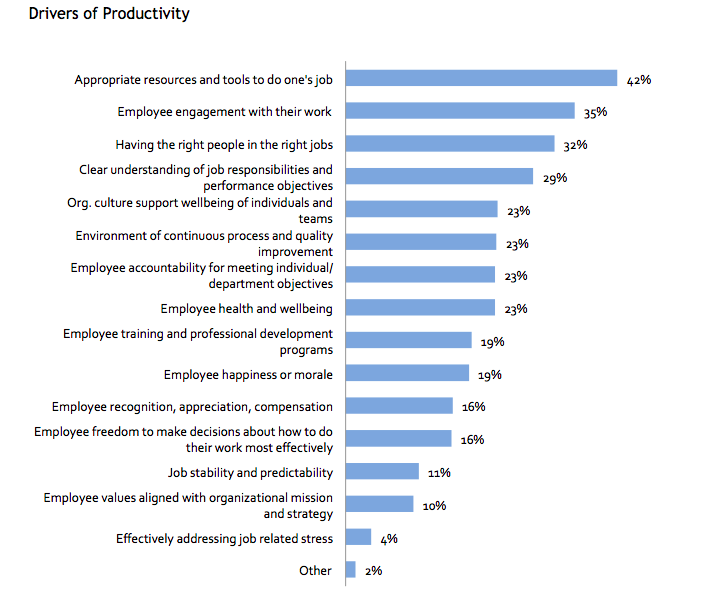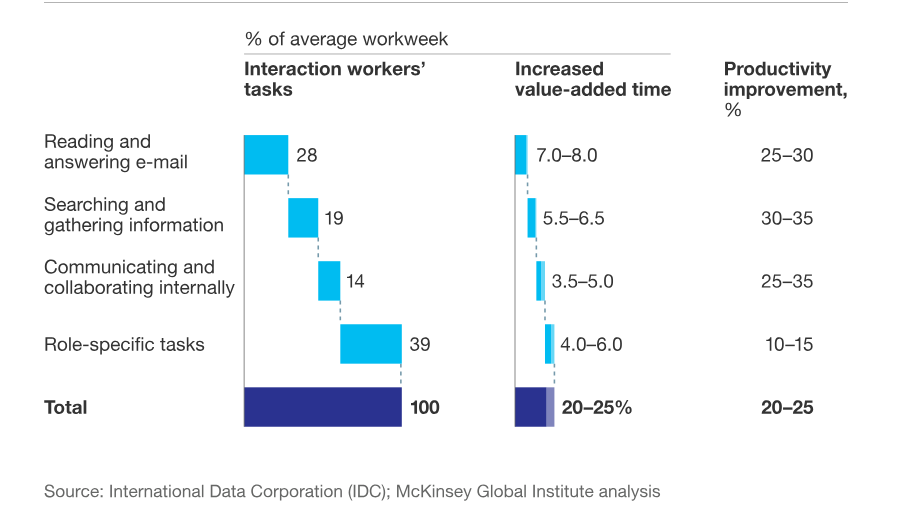“The wealth of business depends on the health of workers.” Dr Maria Neira, Director, Department of Public Health and Environment, World Health Organisation
Officially, we work for only 8 hours a day. But I’d believe that when you love your work, you are always working or thinking about it. And even if it’s true otherwise, I would like to ensure my health and productivity are in perfect condition and efficiency is optimized with just 8 hours a day.
As a Project Manager, managing multiple projects at a time can be extremely difficult as everything is scattered and has different priorities. Fortunately, with experience and a lot of experimentation, I have learned to optimize my own productivity and thereafter discovered techniques to ensure that the teams are healthy and happy. - Abhijeet Sinha, PM@OSL
The scope of improving productivity and efficiency of a team reckons on the manager who should put employee’s health and well-being on a priority shelf and implement policies that can help them stay in good shape. However, health includes both mental and physical well being of the members to achieve successful teams. Many companies miss out on the mental health factor while drafting the policies and lack in extracting 100% efficiency of the team.
Being a manager, one much have already learned how to plan, streamline and prioritize their KRAs(Key Responsibility Areas) to optimize their productivity but the trick is to assist the team members in doing the same. Common doubts among managers include If dictating the processes and tools used should be practiced? How to keep employees from burning out or continuously spinning their wheels?
To understand these, let’s dive deeper!
Drivers of Workplace Productivity
The three broad factors of productivity(diagram below) are interrelated in a dynamic manner:
- Factors like key role areas, corporate policies, management’s attitude towards health and wellbeing comes under the Job and Workplace factor category.
- Personal factors include individual behavior, personal attitude like mental health, financial and family commitments and independent lifestyle.
- Acute and long-term health conditions that can pose as functional limitations in the workplace like blood pressure and cholesterol levels act as Health and Physical factors.
The clear depiction of the relation between the three and work productivity flow gives a fair idea reflecting the effects on productivity of both time pressure and mental health problems at a given point in time.

A study titled Exploring the Value Proposition for Workforce Health resulted in claiming that having the right tools to do one’s job was a priority for 42% of survey respondents as a top driver of productivity, while employee engagement with their work was considered as the top driver of performance by 38% of respondents.
Further, only 12% of vice president-level leaders ticked employee health and well-being as a top driver of performance as employee engagement with their work came out to be the frequently indicated top driver of performance followed by having the right people in the right jobs and having a clear understanding of one’s job responsibilities and performance objectives.

Taking a step back, let’s peek into the factors that should be considered while solving and amplifying productivity at the workplace and can be consciously kept in check too:
- How to deal with problems faced at the time of managing multiple projects/teams?
- How to improve managing the teams with optimized time?
- How to ensure that team health is maintained throughout the project phases apart from being improved?
Strategies to Health, Wellbeing, and Productivity for Businesses
With people around the world being constantly active on the internet, social technologies have taken the forefront and have given rise to social interactions too. Companies are now using it to their advantage and engaging with consumers in new ways. McKinsey Global Institute’s estimates suggest that companies can raise the productivity of knowledge workers by 20-25 percent by using social technologies. By putting technology in use to tap potential clients and conversions, organizations can generate better insights to create targeted strategies. Similarly, these insights aid the high-skill knowledge workers to raise tremendous productivity of the employees through faster internal communication and smoother collaboration.

According to another MGI’s report, The social economy: Unlocking value and productivity through social technologies, the four commercial sectors, namely, consumer packaged goods, retail financial services, advanced manufacturing, and professional services can be explored for their potential economic impact.
Moving forward, let’s take on the strategies that can be executed amid these focus areas to keep the productivity factor in place:
Strategy 1: Strong Foundation For Communication
Personalization as a motto is a powerful tactic for boosting engagement among employees. When employers know how the team communicates and interacts both internally and externally, it becomes an important factor in implementing new tools of communication that are automated with project management software. One can adopt or create realistic health and productivity strategies aligning with business priorities to make it easier to identify problems that can increase the effectiveness of the tools. Commitment from the senior management’s end also plays a crucial role in senior-level management along with leveraging additional resources and sufficient budget that can aid the whole process. Companies that offer safety, stability, diversity, and inclusion, and sustainability to facilitate an integrated employee experience promote an open culture that eases the employees to hold discussions and meetings to bring out the potential in full bloom.
‘Teams with high employee engagement rates are 21% more productive and have 28% less internal theft than those with low engagement.’
Strategy 2: Reduce Structure Rigidity
Companies are adopting location-independent agile teams that can work remotely from different parts of the world and still contribute equally and productively to the common goal of the team. As studies suggest, employees are more productive when working from home without supervisors breathing down their necks. The freedom and liberation lead to more productive and efficient output from the employees deflecting the common myth that working remotely or at home makes people lazy and procrastinate. Having a sense of composure and not burdened by the workload let employees attend to their personal emergencies at the same point too. It is commonly observed, when technology is put in use to get across messages in a creative manner via social media, posters, and apps, the engagement rate pulls the productivity graph too. Often organizations recognize the role of a manager in leading and setting the tone at the workplace that can invest in changes to not just the physical environment but the overall communication and vibe among the colleagues.
‘57% of very stressed employees felt less productive and disengaged, while only 10% of low-stress employees reported feeling this way.’
Strategy 3: Limit distractions
Workplace interruptions are considered as one of the biggest hurdles in productivity as an average employee is interrupted every 3 minutes and 5 seconds. Further, an average interaction among colleagues at work takes 28% of the workweek like managing emails and 20% looking for or tracking down colleagues when seeking help for specific tasks. Having weekly goals in focus with ample time to reflect on them can limit the distractions to a certain extent. However, for faster communication and to curb the gap, internal conversations can be initiated via social technologies. The social interactions can reduce the time employees spend searching for company information by as much as 35% along with adding value that can be realized through faster, more efficient and effective collaboration, both within and across organizations.
For companies that rely heavily on influencing and interacting with customers can drive a considerable amount of attention on social media and improve the communication process. They can extract a richer perspective from the online user base about their requirements or the brand itself. Cutting down the traditional research cost, the algorithms of these mediums captures relevant data and information from the organization that can become the base of implementing productivity measures. As a result, the social communication channels hinges on the full and enthusiastic participation of employees. Also, a more transparent, open and non-hierarchical structure in the organization is a must for fishing out full benefits of social technologies.
Strategy 4: Improve Workplace Environment.
“We shape our buildings, and afterwards our buildings shape us” - Winston Churchill
When it comes to boosting the productivity of the workplace, from the minutest of details like cafeteria facilities to safety of female employees has to be listed as factors that promote healthy employee behaviors. It is believed that building an organizational culture based on health is the primary strategy for nearly 2/3rd of employers. Thus, the promotion of productivity falls on the shoulders of managers who encourage employees and help them reduce workplace stressors. Various mediums like social media networks can be utilized to publicize workplace achievements and other successes that can make each member feel a part of the team.
Employers should invest in promoting impactful behaviors and methods of communication too. For example, not all meetings have to be held in the conference halls. Opting for stand-ups and walking meetings outside the workplace eliminates the power struggle and reduces the friction or stress between the employees. On the other hand, walking meetings adds a breath of fresh air and keeps you and the team fit as opposed to sitting all day in the office. Further, creating health challenges for individuals or team, such as weight-reduction activities, with small incentives or prizes, can increase the level of enthusiasm among the members. Often organizations create a dedicated portal to deliver health-related information and promote health challenges to the team on a regular basis.
Strategy 5: Integrating Global with Local
‘Over 28% of Americans believe work is a source of anxiety’
If the company has operations in multiple countries, it can leverage the global economic factors to scale in the health and well-being programs and address the location-specific needs. An effort to understand the local health and culture practices of the team allows the organization in catering to unique employee requirements that can, in turn, boost productivity. Though the enterprise can follow international standards of health and productivity that can add value creation and centralized the team process, modifications can be done according to the local team.
As reported by IPSOS in an online study, over 28% of Americans believe work is a source of anxiety. However, only one in four employees are said to report it to their managers. Thus, periodic feedback from employees is an important practice that can ensure programs being relevant and feeding the needs of the organization in an ever-changing workforce. This results in the ongoing measurement of program effectiveness and engaging them in pursuing healthier lifestyles.
Strategy 6: Set Example
Talent, high engagement, and 10+ years of service within the company are said to be the most common traits of high performing employees. A team doesn’t like to follow orders but footsteps of the senior management. The first step should be to get your own behavior and actions in order to exhibit good time-management practices. From attending meetings on time to being responsive on emails, managers should set an example for the team. By modeling this behavior, you are letting them know what matters to the organization and showing actual proof via actions. It is observed among employers in all regions that work environment is the most important asset in affecting employee behavior change. The day-to-day experience of employees becomes critical in gaining the trust around personal issues and convincing them that their employer is a go-to resource. It also highlights a potential opportunity for employers to strengthen the team spirit and maintain uniformity in workplace endeavors.

Further Challenges
Over and above these productive trends, there are a number of challenges for both employees and employers that hinder in the successful implementation of health and wellbeing programs. The most common of the challenges is the one where the managers fail to recognize and prioritize mental health as a huge factor against other operational demands. The lack of understanding and best practices to overcome this barrier is a big differentiator and shows in the performance of the employees only in the long run. Factors like workplace stigma and perceptions around mental health exacerbate the challenges further and arrest the organization from promoting improvements.
An organization should relentlessly focus on investing time and resources into the wellness programs to position their growth and future success. As productivity gains can be achieved up to 15% by upgrading the workplace environment, here are some key points on offering a successful wellness program:
- The program in action should be sustainable and operational on a day-to-day basis
- Ensuring an attitude of ‘always doing more’ for employee health and wellbeing
- Understanding the costs of mismanaging health and wellbeing issues
- Initiating regular one-on-one contact with employees focusing on the individual and not just the whole
- Keeping a check on the needs of the workforce by seeking feedback on initiatives regularly
- Monitoring a wellness program by giving ownership to senior leaders to play an active role and take on responsibilities.
- Attracting top talent during the recruitment process by promoting the workplace wellness program
- Using creative mediums rather than traditional means to publicize and promote the health and wellbeing initiatives to existing employees

Case Studies
Astonishing Productivity Boost of Working From Home
A Stanford professor, Nicholas Bloom took a 2-year study that shows Astonishing Productivity Boost of Working From Home. He designed a test where 500 employees were divided into two groups, a control group who continued working at HQ and volunteers who opted for work-from-home for at least six-month tenure. The jury wanted to analyze the productivity effect of working from home and it has returned with a surprising verdict. The results portrayed that the employee attrition decreased by 50% among the telecommuters, as they took shorter breaks, fewer sick days, and less time off. This also reduced the carbon emissions from fewer vehicles clogging up the morning commute.
Thus, the sum total of the research led Bloom is indicative of embracing and enabling the benefits of working from home but enabling it just a few days a week versus its being a constant.
Employee Motivation, An Organisational Performance Improvement Strategy
It is a global desire of every organization and business owners to become successful. The major challenges faced by organizations include employee retention, technology, and market focus following the competitiveness in the current era. The researchers of this study asserted that an employee’s motivation determines any business facet’s success. They considered employees as an asset with the highest significance in an organization and considered motivation as a significant factor in the achievement of its growth as the key.
Further, they noted that the capability of drawing, holding and advancing employees that are talented are the main characteristics of a business that is successful. The research concluded that a stressed, exhausted and demoralized mind is directly associated with poor performance while a motivated mind and heart remains focused on the organizational goals hence improved productivity and performance.
Conclusion
Healthy employees bring health and wealth to the company by working better and faster and henceforth showcase the potential to boost the company’s productivity. Across the globe, business leaders believe that productivity and health should be viewed as an investment in human capital. However, for everyone who views it as a core health strategy, there is an equivalent number that views health as an added expense.
Nevertheless, your teams’ health and productivity are directly co-dependent on your business’s growth which makes it important to look after your employees. Thus, implementing these tips makes for a win-win situation for everyone.
Subscribe
Related Blogs
Exploring Drupal's Single Directory Components: A Game-Changer for Developers

Web development thrives on efficiency and organisation, and Drupal, our favourite CMS, is here to amp that up with its…
7 Quick Steps to Create API Documentation Using Postman

If you work with API , you are likely already familiar with Postman, the beloved REST Client trusted by countless…
What is Product Engineering Life Cycle?

Imagine constructing a house without a blueprint or a set of plans. It will be challenging to estimate the cost and labor…




